CONTENTS
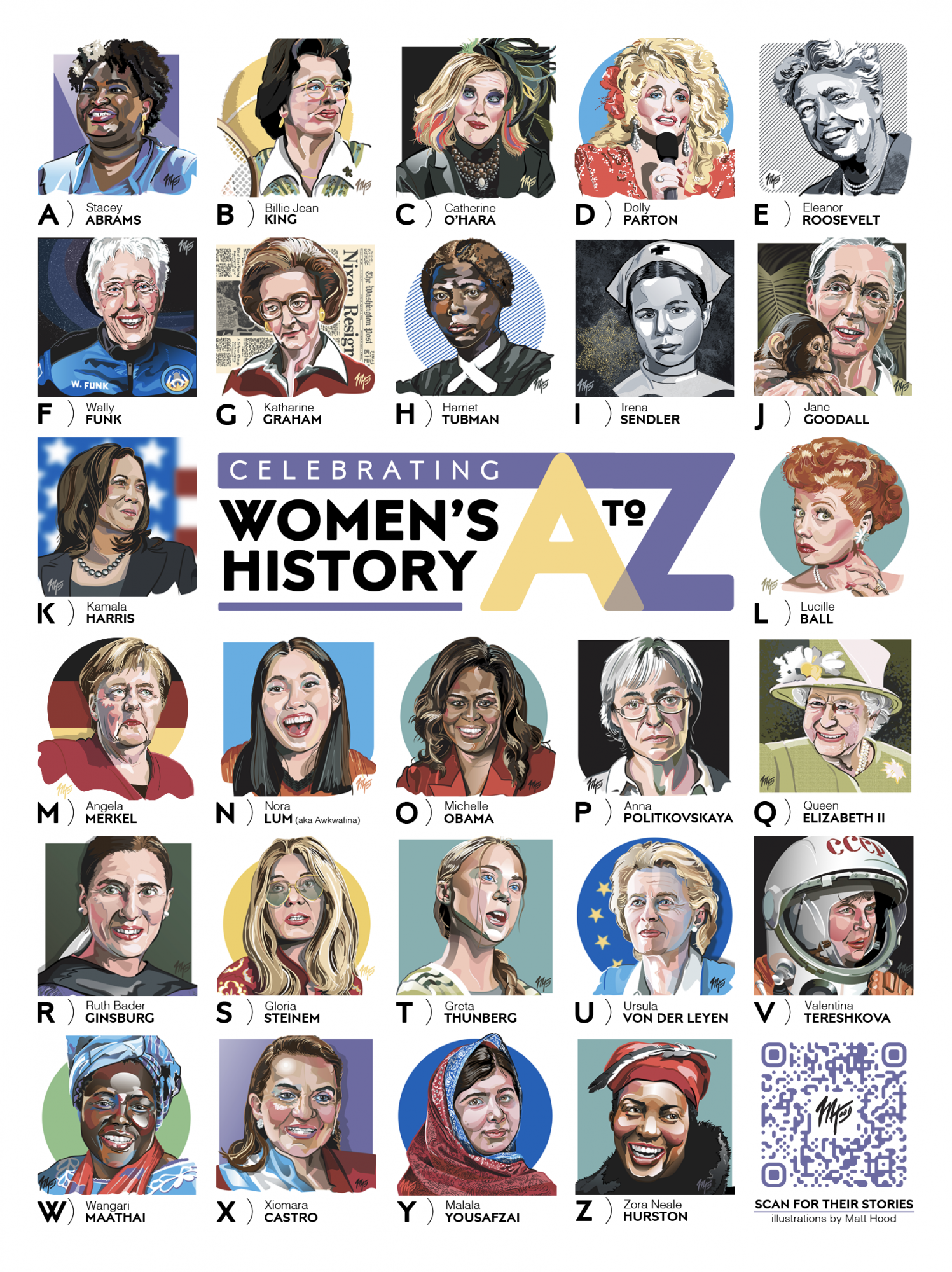
Welcome to
Women's History
A to Z
Graphics Without Borders celebrated Women’s History Month in March of 2022 with 26 portraits of female leaders, legends, influencers and icons.
The women I chose came from 10 different countries, many different cultures, from a nonagenarian to a teenager. Some of my choices have already passed away, and some have barely started to change the world. Artistically, I’ve used an extensive palette of colors to illustrate this diverse group of leaders, icons and influencers. Some of my choices are cannon, the greatest hits of Women’s History, so to speak. A lot of them, I hope, will be women whose names and accomplishments are new to you.
– Matt Hood
Buy one for yourself or as a gift

A is for Stacey Abrams
This is what dedication to democracy looks like.
Abrams is a lawyer, author and voting rights advocate who served in the Georgia House of Representatives from 2007 to 2017. In 2018 she was the democratic nominee for Georgia governor, the first time an African American woman won a major-party gubernatorial nomination in U.S. history.
She narrowly lost to her Republican opponent in a general election. But instead of slinking off to lick her political wounds, Abrams instead founded Fair Fight Action, an organization to address voter suppression and address the constitutional rights of historically disenfranchised voters.
Largely thanks to her efforts, Joe Biden won in Georgia in 2020 and so did two Democrats running for the U.S. Senate, giving Democrats the White House and a razor thin majority in Congress.
Abrams has announced she’ll run for governor of Georgia again this year.
B is for Billie Jean King
King is considered one of the greatest tennis players of all time with 39 Grand Slam titles. Some might hasten to say greatest “female tennis players,” but off the court, some of King’s best accomplishments were all about removing the distinction and discrimination between “male” and “female.” She has been influential in the realm of gender equality, pay equity and social justice.
King was key in getting women tennis players a well-funded league of their own in the 1970s. In 1973 she beat Bobby Riggs in an exhibition match dubbed the “Battle of the Sexes.”
King’s sexuality also put her in a spotlight and has made her an LGBTQ icon. She was outed in 1981 at the age of 38 but felt she had to deny her true sexuality based on the politics of the day. It wasn’t until she was 51 years old that she was able to speak openly with her parents about being gay.
“That was a turning point for me as it meant I didn’t have regrets any more,” King told the Sunday Times in 2007.
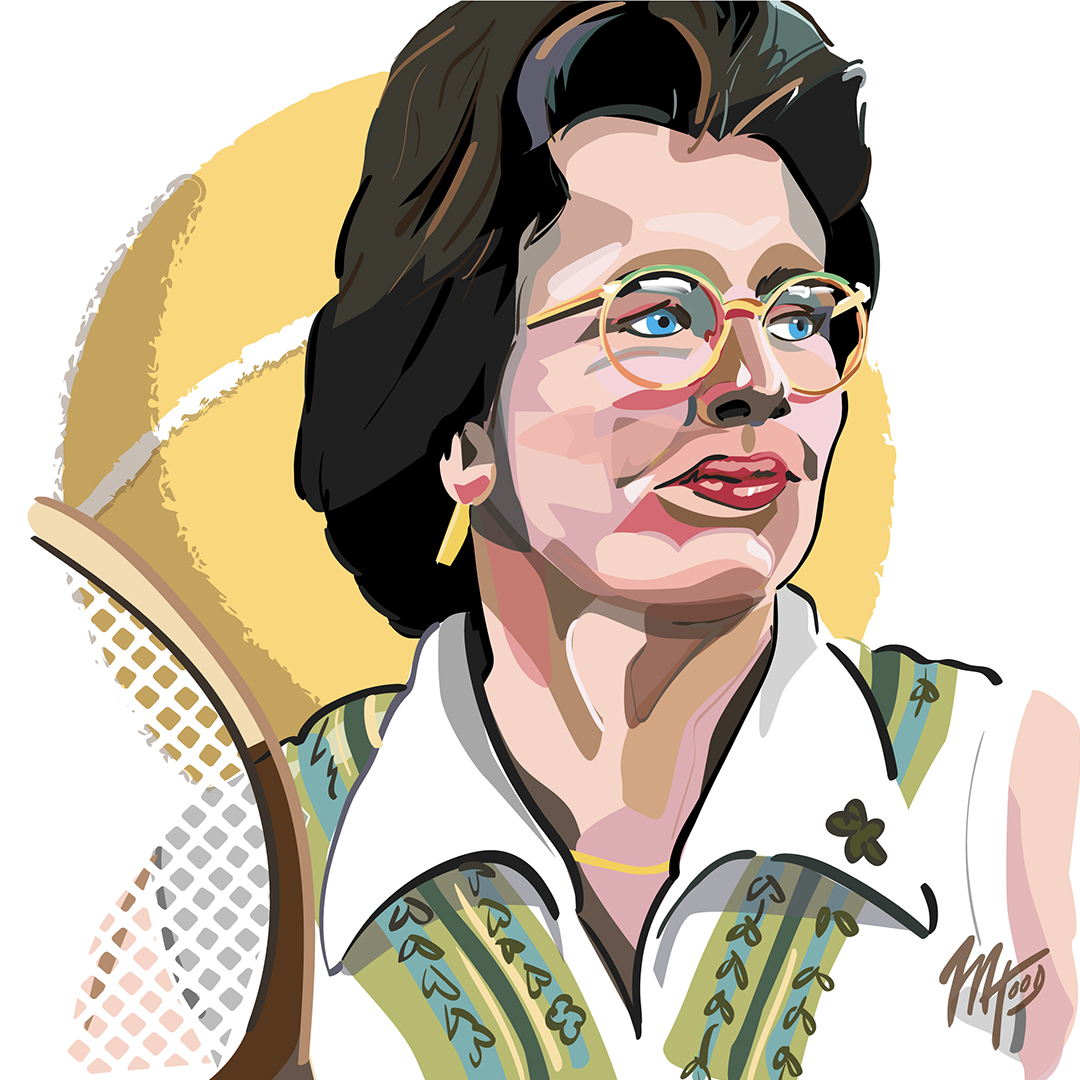

C is for Catherine O'Hara
I chose O’Hara for all the chuckles and downright guffaws she has given me through the years. “Beetlejuice,” “Home Alone,” any of her mockumentries with Eugene Levy. Which brings me to my favorite role: Moira Rose on Schitts Creek. Much has been said about the show’s brilliant comedic writing, its themes of unhindered inclusion and character arcs that went from superficial superiority to profound and accepting humility, and all of it is true. O’Hara deserves specific credit, however, for some of Moira’s more iconic character ingredients. The wigs and the indeterminate haughty accent were all O’Hara’s additions.
“What you did was impulsive, capricious, and melodramatic… but it was also wrong.” — Moira Rose.
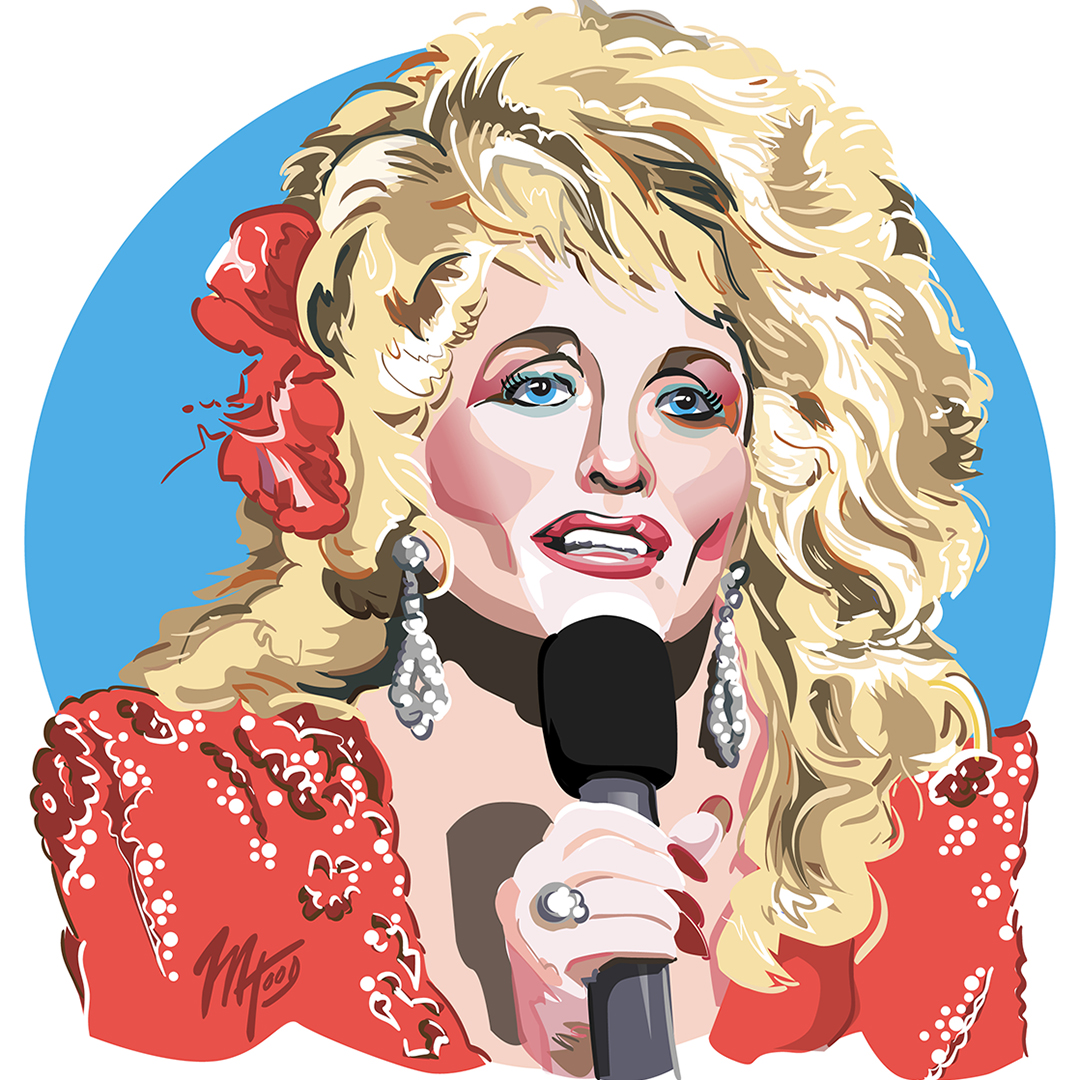
D is for Dolly Parton
“I will always love you.” It’s not just one of Dolly’s famous songs, but it’s also a fair assessment of how millions of fans feel about the country singing icon. Born in a one-room log cabin on the banks of the Little Pigeon River in Tennessee, Parton has gone on to superstardom and near universal admiration from fans of all ages, backgrounds and political bents.
Parton has penned more than 3,000 songs, 25 of which have become Billboard No. 1s. She’s been nominated for 50 Grammys, winning 11. Whether it’s music, movies, books, or business, Parton has a golden touch across all arenas.
For all that she has given the world in entertainment, she has perhaps given even more in terms of philanthropy. She is a devoted Christian, showing her love for her fellow humans without asking them to change. She is a multimillionaire who is dedicated to giving to those less fortunate. Her Dollywood foundation has brought jobs and development to previously economically depressed areas. She’s raised money for the Red Cross and for HIV/AIDS-related charities. She’s given hundreds of thousands of dollars to protect wildlife and the environment. In response to COVID, she gave $1 million dollars in research funds to Vanderbilt University Medical Center, which was vital in the development of the Moderna vaccine.
She is also a dedicated advocate for education. Her Imagination Library started in 1995 with a mission statement of delivering free, high-quality books to children from birth to age five in the Tennessee county where Parton grew up, regardless of the family’s income. The program quickly grew beyond the borders of Tennessee. By 2003, the program had mailed more than 1 million books around the world. And it’s grown exponentially since.
E is for Eleanor Roosevelt
Eleanor Roosevelt was the First Lady of the United States from 1933 to 1945 and served as the United States Delegate to the United Nations General Assembly from 1945 to 1952. For all of her diplomatic and humanitarian contributions, President Harry Truman referred to Roosevelt as the “First Lady of the World.”
After an illness left her husband, Franklin Delano Roosevelt, without the use of his legs, Eleanor often appeared for him in public. She held 348 press conferences during her time in the White House. Although the U.S. has not yet elected a woman President, in many aspects such as involvement and even decision making, Eleanor was the first woman to fill this role.
Eleanor was not particularly popular as a first lady, because her views of civil rights, women’s rights, and fair pay were so progressive for her time.
Roosevelt was a proponent of women’s trade unions, a minimum wage, and the abolition of child labor. As First Lady, she was also often vocal about how her husband’s New Deal policies were often discriminatory against African Americans in the South.
Eleanor Roosevelt’s health declined after a car accident in 1960, and she died in 1962 at the age of 78. President John F. Kennedy ordered that all U.S. flags around the world be flown at half staff in tribute.
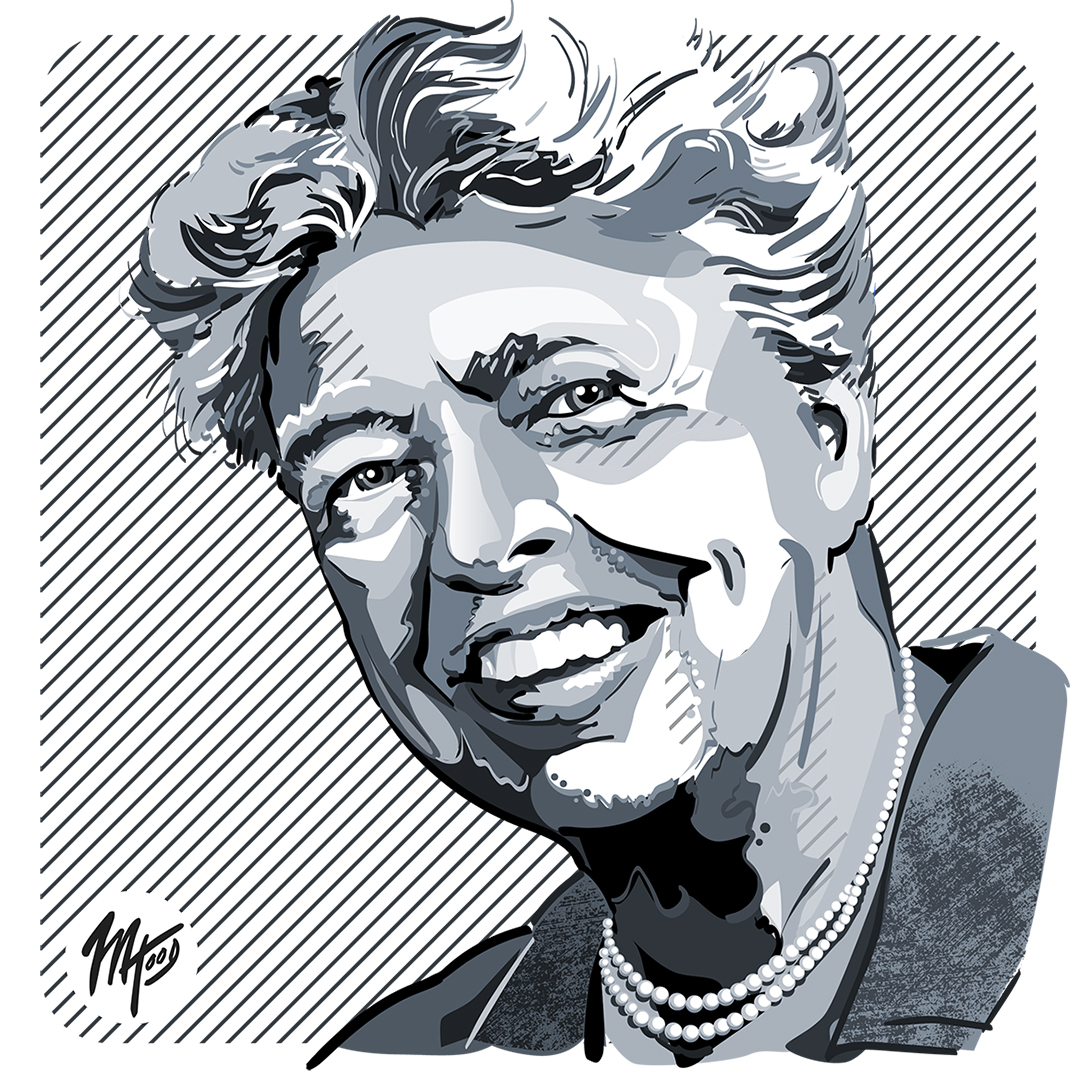
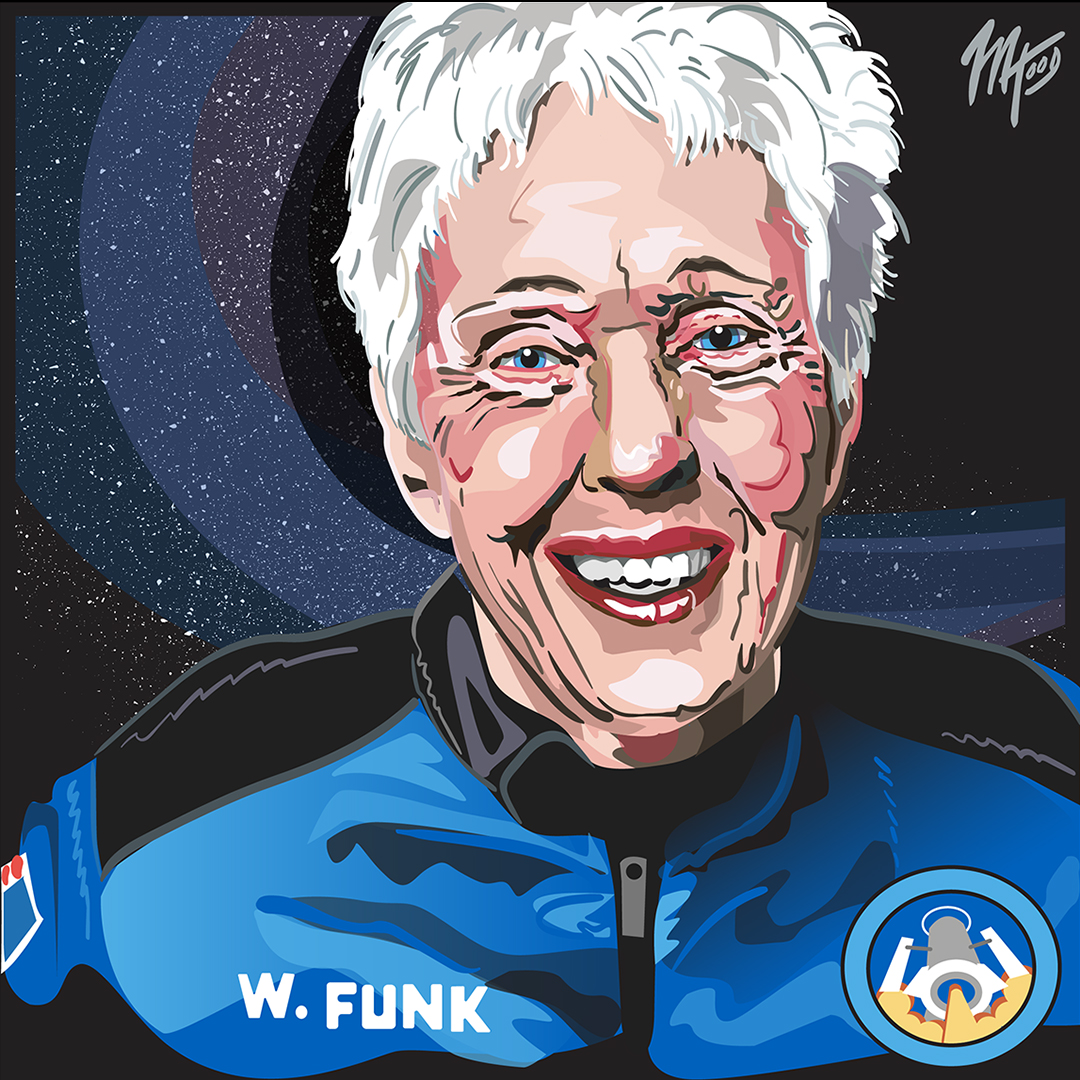
F is for Wally Funk
Funk’s story is truly inspirational for any little girl who has ever been told she can’t do something. Mary Wallace “Wally” Funk, born Feb. 1 1939, proves that through talent, determination, and persistence, little girls can go on to truly reach the stars.
From an early age, Funk was obsessed with flight. At her high school in New Mexico, Funk wanted to attend courses in mechanical drawing and auto mechanics to prepare her for working with planes. But she was told that, as a girl, she could only take home economics. So, she left high school early, entered college and graduated with a pilot’s license and a degree.
At the age of 20 she became the first female flight instructor (civilian) in the United States military. She went on to work at the Federal Aviation Administration (FAA) and the National Transportation Safety Board (NTSB).
In 1961, Funk volunteered for the “Women in Space” program. Twenty-five women were invited to take part. Only 13 graduated after rigorous mental and physical testing. They were dubbed the Mercury 13 after NASA’s Mercury program that featured such famous astronauts as John Glenn and Alan Shepard.
In the end, the program was cancelled. None of the 13 went to space… in the 1960s, that is!
Undeterred, Funk applied to NASA three times to become an astronaut in the 1970s. But despite her qualifications, she was refused each time because she didn’t have a degree in engineering, nor had she been a test pilot –– the criteria of the day for becoming a NASA astronaut.
Enter civilian space flight. In July 2021, Blue Origin announced that Funk would pilot the first flight of their New Shepard suborbital spacecraft. One of the other passengers on the flight would be Jeff Bezos, the billionaire founder of Amazon and the guy who paid for the rocket. That’s some vote of confidence!
On July 20, 2021, Mary Wallace Funk at the age of 82 became the oldest person to go to space, breaking a record John Glenn had held for 23 years. (Actor William Shatner, age 90, usurped that record three months later. But Funk is still the oldest woman in space, and unlike Capt. Kirk, she actually steered the ship.) Aim for the stars, girls!
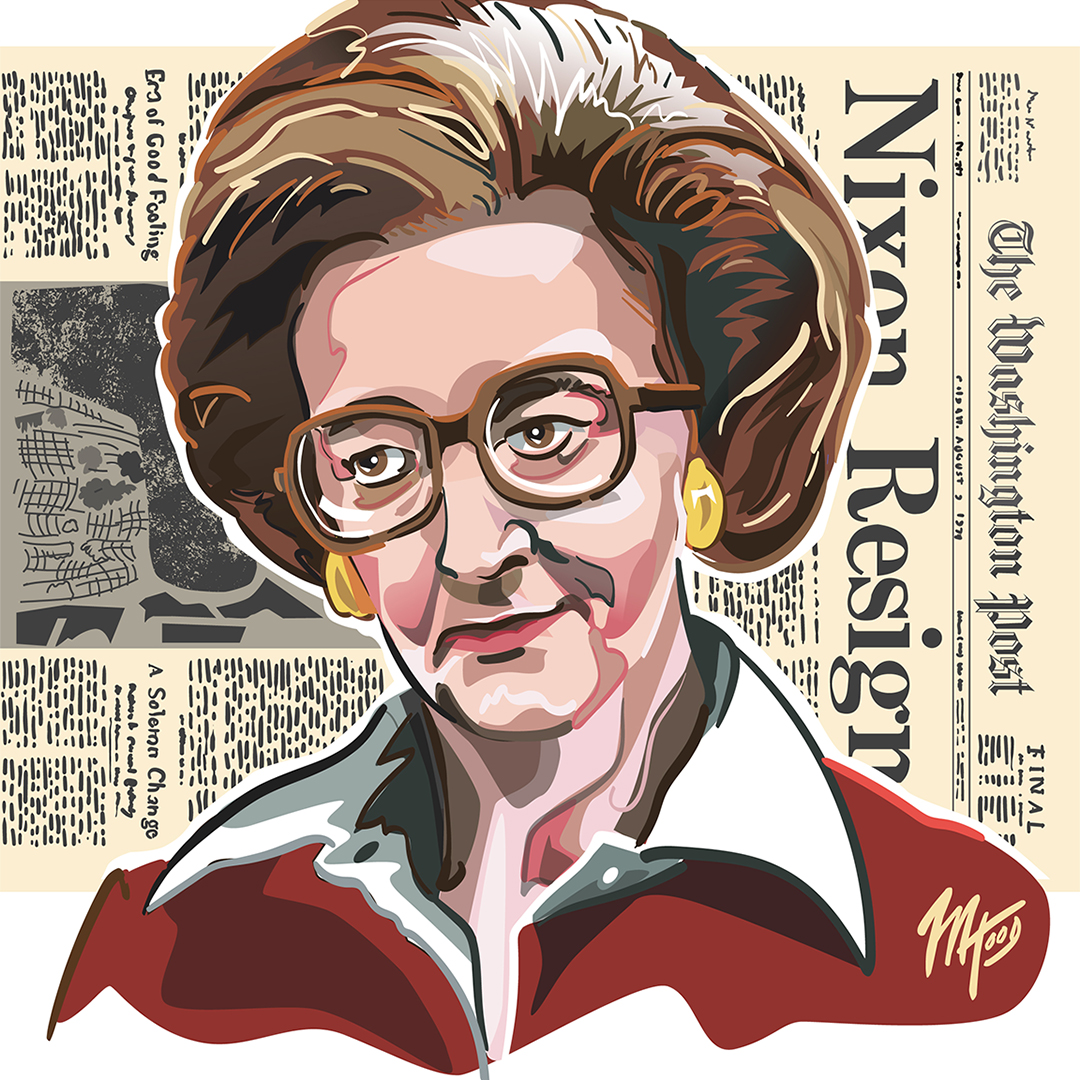
G is for Katharine Graham
Katharine Graham was the publisher of The Washington Post from 1963 to 1979, a time that coincided with the newspaper’s coverage of history-shaping stories about the Pentagon Papers and Watergate.
Graham’s father, Eugene Meyer bought The Post at a bankruptcy auction in 1933, and Kay’s husband, Phillip Graham, was made publisher in 1946. After Phillip’s death by suicide in 1963, Katharine took over leadership of the paper.
At the time, Graham was very much the one female member of an all boy’s club. No other woman ran a large, metropolitan newspaper. In 1972, when The Washington Post Company joined the ranks of the Fortune 500, Graham was the first and only female CEO on the list.
Graham hired Benjamin Bradlee as executive editor of the paper in 1968. When reporters Bob Woodward and Carl Bernstein first brought the Watergate stories to Bradlee, it was Graham who supported and encouraged their continued investigation. As a result, The Post ran stories about Watergate when few other papers were covering it. The investigation revealed politically motivated crimes that lead Richard Nixon to resign the presidency in 1974.
In 1972, Nixon’s attorney general John Mitchell was trying to warn Carl Bernstein not to publish a forthcoming article. “Katie Graham’s gonna get her tit caught in a big, fat wringer it that’s published,” Mitchel said. The Post published the quote, although Bradlee excised the words “her tit.” Some years later, friends presented Graham with a golden broach in the shape of a breast being squeezed between two rollers. Graham donated the pendant to the Washington D.C.-area Newseum where it became part of their exhibit on Watergate.
Graham’s son, Donald, became publisher of the Post in 1979, but Katharine remained chairwomen of the board until 1991. Her memoir, “Personal History,” won her the Pulitzer Prize in 1998. On July 14, 2001, Graham fell and struck her head. She died three days later.
It is in no small part because of Graham’s determination, bravery and refusal to be intimidated by powerful men, The Washington Post is the citadel of great journalism it is today.
H is for Harriet Tubman
Harriet Tubman was an abolitionist and political activist who helped liberate nearly 800 enslaved people before and during the Civil War. She was born into slavery in 1822 as Amarinta Ross. Harriet was her mother’s name, which Tubman took as her own when she reached freedom.
Tubman was raised on a plantation in modern-day Dorchester County on Maryland’s Eastern Shore. She spent almost 30 years enslaved until poor health prompted her owner to try to sell her. The impending sale meant her family would be torn apart, so she escaped north into Pennsylvania—a journey of nearly 90 miles on foot.
In the years to come, Tubman made 13 trips back into Maryland and rescued approximately 70 enslaved people, including her family. She usually traveled at night and during the winter months so that she and her charges would be less likely to be seen by fellow travelers. Once she had made surreptitious contact with a group of escaping slaves, she would wait to leave town until Saturday evenings, because the newspapers would not print runaway slave notices until Monday. Tubman’s escape route and the series of safe houses where she and her entourage stayed came to be know as the Underground Railroad.
After passage of the 1850 Fugitive Slave Act, Philadelphia was no longer a safe final destination for the Railroad, as law enforcement officials were required by the new act to return escapees to their enslavers even if they were caught in areas where slavery was outlawed. So Tubman helped her companions travel all the way to Canada.
When the Civil War began, Tubman served as an armed scout and spy. She led an expeditionary force of Union soldiers during a raid of Combahee Ferry in South Carolina. The raid liberated more than 700 enslaved people.
Tubman was well known and respected during her lifetime. She used that notoriety later in life to advocate for women’s suffrage. She died on March 10, 1913.
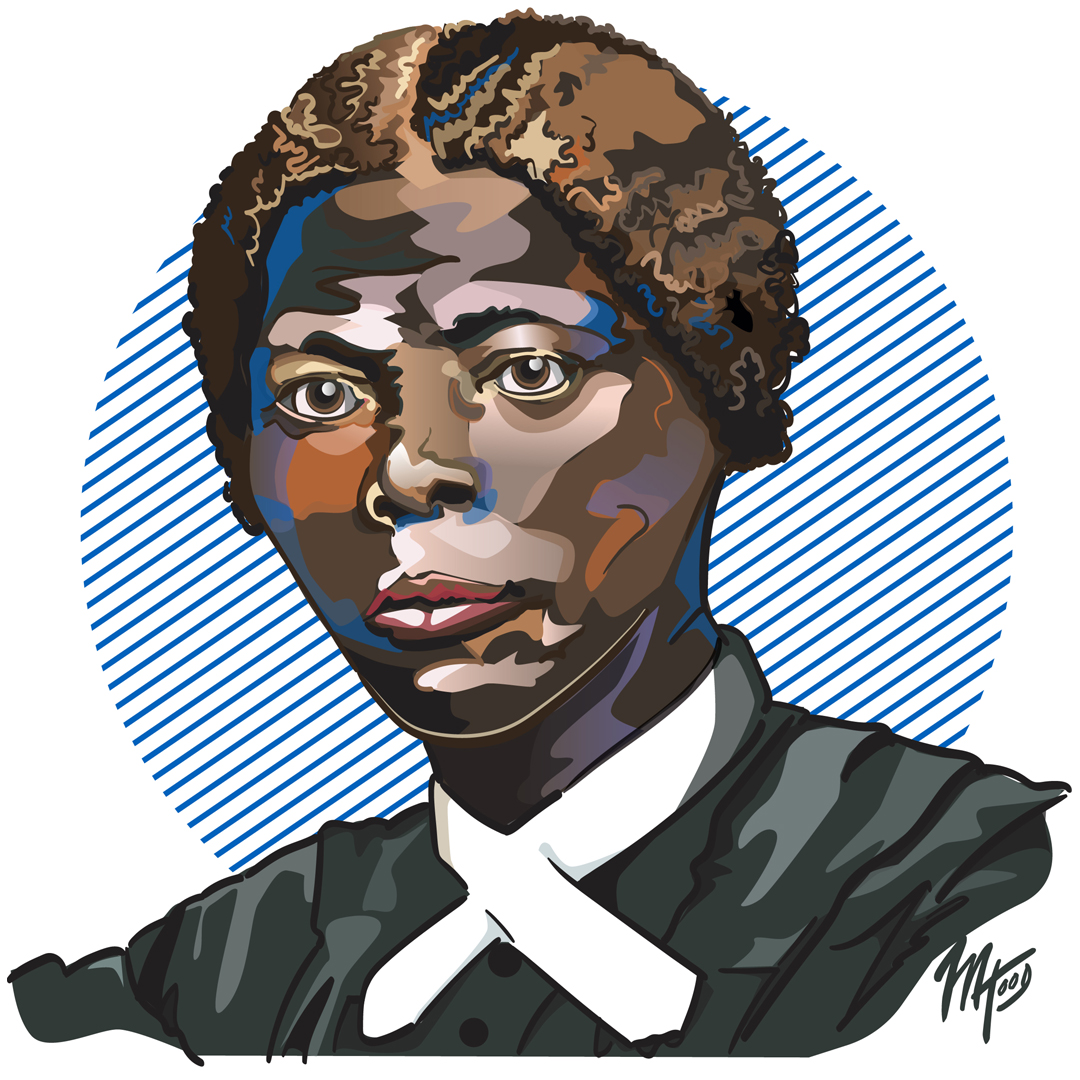
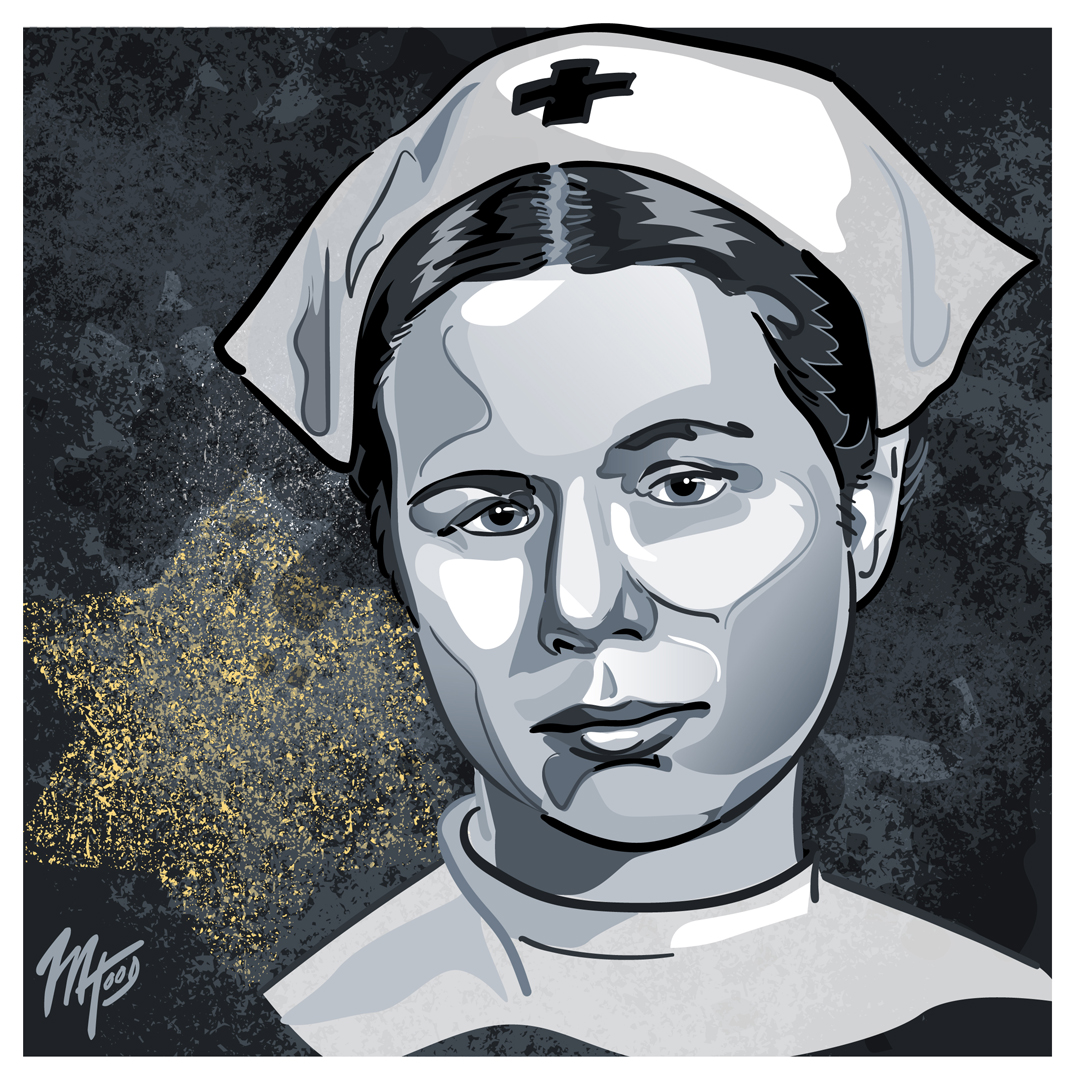
I is for Irena Sendler
Irena Sendler (also referred to as Irena Sendlerowa in Poland) was a Polish nurse in charge of the Children’s Division of Zegota, a covert group dedicated to helping Jews in Nazi-occupied Warsaw. Between 1942 and 1943, Sendler and her network of 10 other compatriots rescued 2,500 Jewish children from the Warsaw ghetto.
When the Nazis invaded Poland, the Jews of Warsaw were imprisoned inside a one-square-mile ghetto. As a nurse, Sendler was allowed by the Nazi authorities to enter and leave the ghetto on a daily basis. She used that access to reach out to Jewish parents and convince them to give her their children. She smuggled them out in sacks or hidden in vehicles.
For each child she saved, she and her network gave them new Christian-sounding names and placed them with foster families or in Catholic orphanages. Sendler, though, kept lists of the children’s true identities and their new locations, which she buried in jars.
Even when she was captured and tortured by the Gestapo, Sendler never gave up the list nor the names of her fellow conspirators. She was sentenced to death but escaped. After the war, she used those hidden lists to help reunite as many children as possible with their surviving families. But survivors were tragically few. Approximately 35,000 Jews died in the Warsaw Ghetto and more than 260,000 were deported to the Treblinka death camp.
In 1965, Yad Vashem, Israel’s official memorial to victims of the Holocaust, named Sendler as one of the Righteous Among the Nations. In the 2000s, Sendler received Poland’s highest civilian honor and personal recognition by Pope John Paul II. Sendler lived in Warsaw for the rest of her life and died in 2008 at the age of 98.
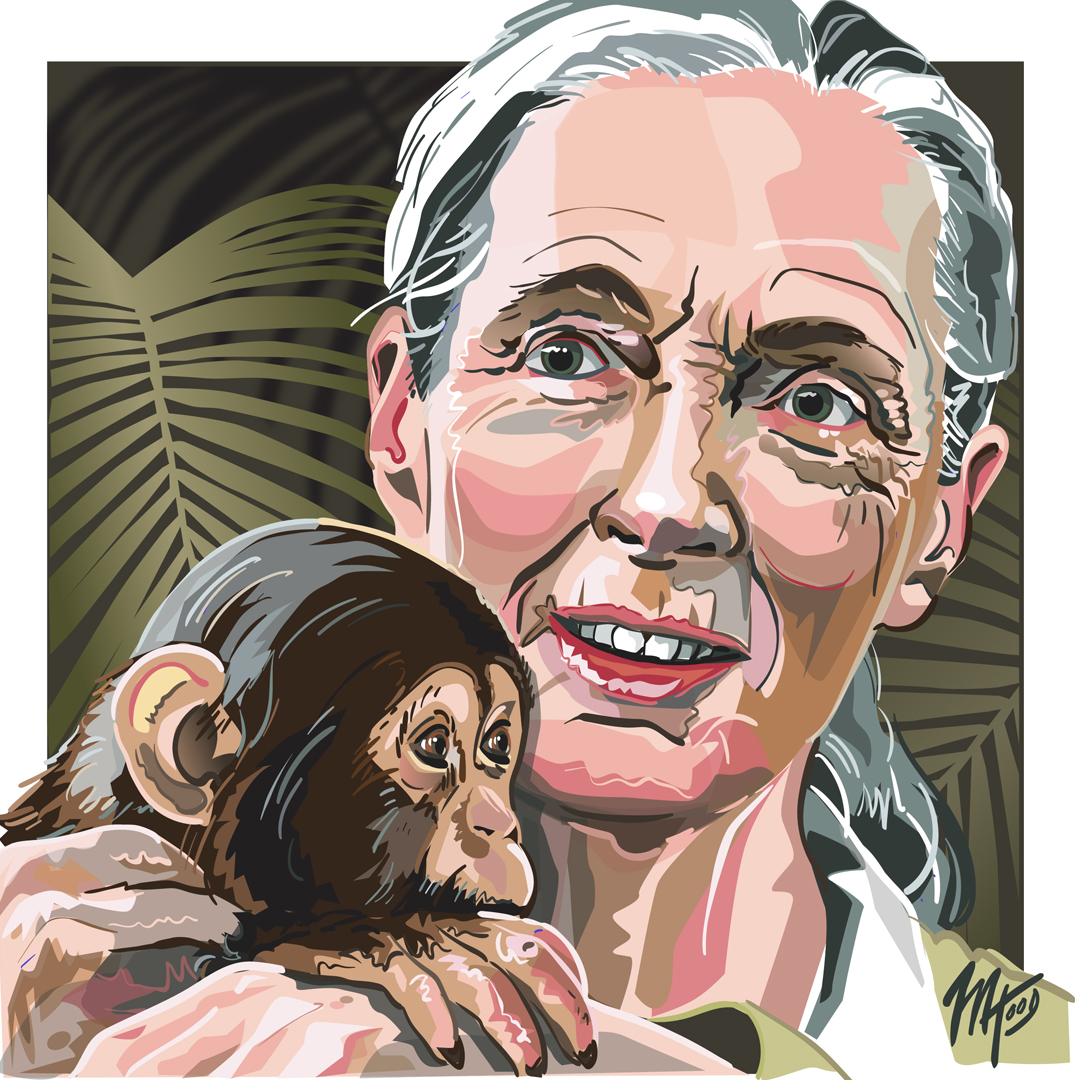
J is for Jane Goodall
Jane Goodall is a British primatologist and anthropologist. She is considered the world’s foremost authority on chimpanzees thanks to the nearly 60 years she has spent studying wild chimpanzees of the Gombe Stream National Park in Tanzania.
Goodall’s extensive research among the Gombe chimps has greatly increased academic knowledge of primate social and familial behavior. It was Goodall who discovered that chimpanzees use tools when she observed a chimp using a stick to fish out termites from their underground nest. Until this groundbreaking discovery, the use of tools was considered one of the features that distinguished humans from animals. It was also previously unknown that chimps eat anything other than fruits and vegetables.
In 1977, Goodall formed the Jane Goodall Institute. With offices in 19 countries around the world, the institute is dedicated to worldwide conservation and the protection of primates and their habitats. Today, even at the age of 87, Goodall travels almost 300 days a year advocating for chimpanzees and protection of the environment.
K is for Kamala Harris
Kamala Harris has broken through some of the highest glass ceilings in the world. Not only is she the first woman to serve as Vice President of the US, she is also the first African American and first Asian American to be Vice President.
Harris was born in Oakland, California, in 1964. She graduated from Howard University in Washington, D.C. and returned home to the Bay Area to study law at the University of California, Hastings College. Her career in law started as a prosecutor in various California district attorney’s offices.
Her career in politics began in 2010 when she was elected attorney general of California. She was elected to the United States Senate in 2016 becoming only the second African American woman and the first South Asian American to serve as a U.S. Senator.
As a Senator, she was a healthcare advocate, favored decriminalizing the sale of marijuana, supported a pathway for undocumented immigrants to become citizens, and advocated for a ban on assault weapons. She gained national attention during confirmation hearings for Trump administration nominees. She was particularly pointed in her questioning of Supreme Court nominee Brett Kavanaugh, who was accused of sexual assault.
She ran for President in 2020 but withdrew early in the primary process. When Joseph Biden won the democratic nomination, he selected Harris as his running mate for the general election.
With the Senate equally divided with 50 Republicans and 50 senators caucusing with the Democrats, Harris has been repeatedly called upon to fulfill her Constitutional duty to break any tie votes in the chamber. So far, she has cast 13 tie-breaking votes, the most since John Adams in 1790.
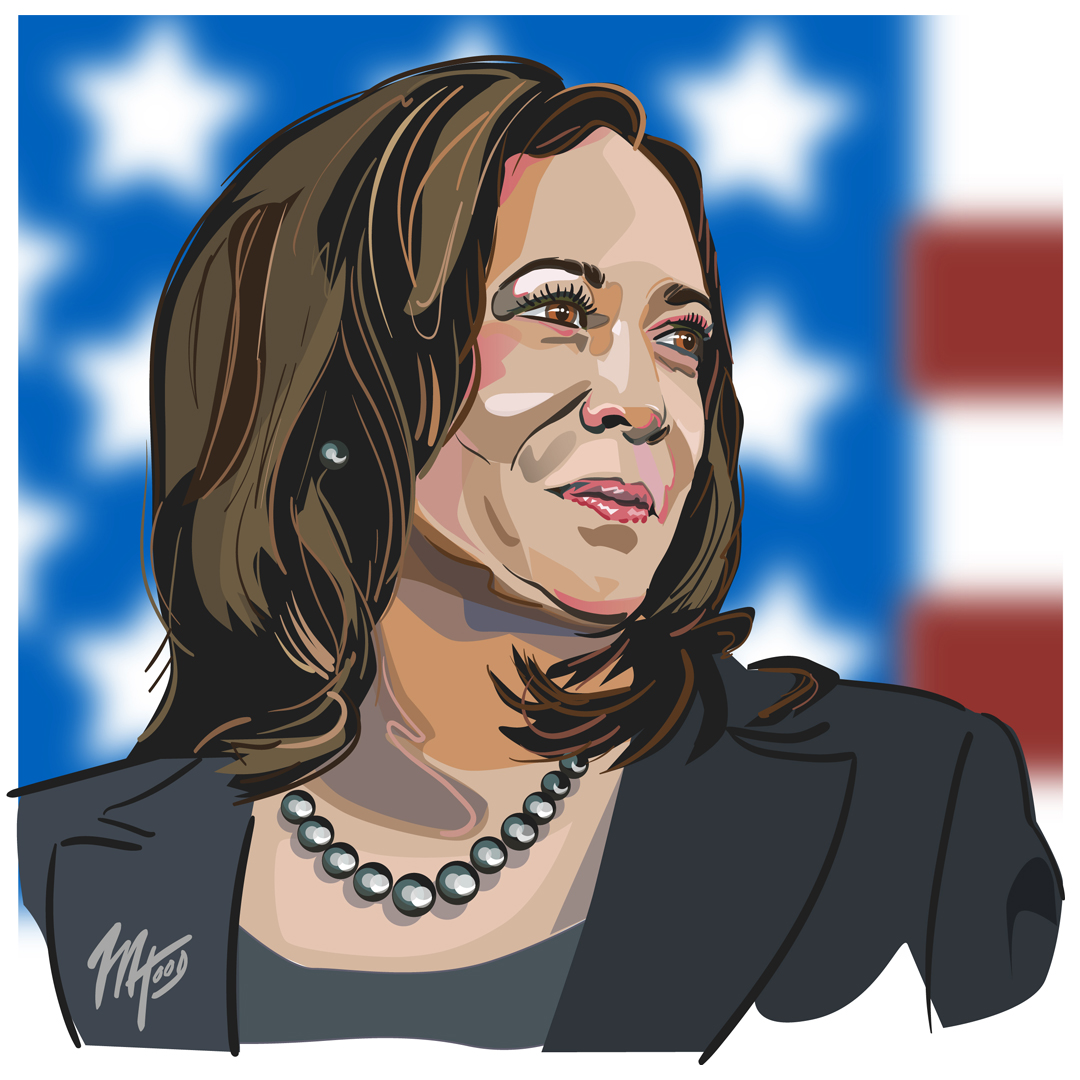

L is for Lucille Ball
Lucille Ball was the original queen of TV comedy, but she was also an astute businesswoman and the first female to run a major television studio.
Ball was born in 1911 in Jamestown, New York to working class parents. Her father died of typhus when she was only three years old. Her mother enrolled her in acting school in New York City when she was 14, despite the financial hardship to the family, in order to get her away from a 21-year-old hoodlum boyfriend in the neighborhood. Her acting teachers told her she would never make it in show biz.
In the late 1920s, Ball started booking gigs as a model. By the 1930s she was working as a voice actress on radio shows and landed a role on Broadway. Then in 1940, she was cast as the lead in a musical where she met and fell in love with Desi Arnaz, who played her bodyguard.
“I Love Lucy” grew out of a radio comedy show called “My Favorite Husband,” in which Ball played a wacky wife. CBS wanted to turn the show into a TV sitcom, but balked when Ball wanted her real-life husband, Arnaz, cast as her on-screen love. The 1950s studio execs didn’t think America was ready for a White, red-head and a Cuban singer as a couple. Ball and Arnaz took their show on the road, literally, as a traveling vaudeville act to prove them wrong. The act was so popular that CBS relented. The rest is TV history.
Along the way, Ball was making other history. By 1960, Ball was the CEO and very active creative director of Desilu studios, a company she had founded with Arnaz and then took full control of after the couple divorced. She was responsible for green-lighting such iconic shows as The Untouchables, Star Trek, and Mission: Impossible (the 1960s original TV versions, not the movie remakes).
When Ball sold her shares of Desilu in 1967 to the production company that would become Paramount, she earned $17 million (about $132 million in 2022 dollars).
Ball made occasional guest appearances on TV in the 70s and 80s. Her last public appearance was as a presenter at the 1989 Oscars. She died of aortic aneurysm on April 26, 1989.

M is for Angela Merkel
Raised behind the Iron Curtain in a time of political distrust and global divisions, Merkel became the first female leader of a reunited Germany and did a great deal to set a unified tone for a post-Cold War Europe. During her time as Chancellor of Germany from 2005 to 2021, Merkel was, by many metrics, the most powerful woman in the world.
As a youth in East Germany, Merkel joined the Communist youth movement, which was essential to educational opportunities in that Soviet sphere. She earned a doctorate in quantum chemistry from Karl Marx University in Leipzig.
Merkel’s interest in politics coincided with the fall of the Berlin Wall in 1989. In 1990, she won a seat in the Bundestag and was appointed to serve as Minister for Women and Youth. Stints as Minister for Environment and an eventual leadership position within her CDU party followed.
In 2005, Merkel challenged the sitting chancellor, Gerhard Schroder, in national elections. The results were extremely close, but a coalition was formed with Merkel as Germany’s first female chancellor.
Her initial years as chancellor were marked by sinking unemployment. She was also a steady hand in steering Germany through the European debt crisis. Her popularity was hurt in some circles in 2015 when she opened Germany’s borders to refugees fleeing war in Syria. But the move undoubtedly saved thousands of lives. And in typical German fashion, the refugee acceptance programs were exceedingly well organized. Families were placed all around Germany so no one area was overtaxed. They were given temporary housing and the chance to take free, state-run German language classes. Soon, these one-time refugees were an integrated part of German society.
Merkel was an advocate of a unified European response to terrorist attacks. She was prescient in her belief that Germany shouldn’t be too reliant on Russian energy. And she was praised for her science-based approach in the early days of the COVID pandemic.
In 2018, Merkel announced she would not run for re-election in 2021. At the end of her term, after 16 years, she had a 67% approval rating.
N is for Nora Lum (aka Awkwafina)
Lum is an Asian-American actress, rapper and comedian who has proven that girls who get their start writing and recording songs on their Mac can grow up to be super heroes.
Born in New York, to a Chinese-American father and a Korean-American mother, Lum grew up in Queens where she played the trumpet and studied classical music and jazz. She adopted the stage name Awkwafina at age 15 as an alter ego to the quiet and retiring Asian girl she was supposed to be.
She started rapping at 13 and started mixing and recording songs on her Mac. In 2012, her song “My Vag” became a hit on YouTube and led to a hip-hop album in 2014. Within a few years, she was working as a DJ in New York, was collaborating with comedian Margaret Cho, and had landed small parts in movies and voice work in cartoons.
In 2018, she had staring roles in “Oceans 8” and “Crazy Rich Asians.” A year later she starred in “The Farwell” a comedy-drama directed by Lulu Wang based on a true story of a Chinese family who refuses to tell the family’s matriarch that she is dying of cancer. Perhaps it was the power of collective positive thought, but the grandmother — still in the dark about a prognosis that had given her only months to live — was still alive many years later to see the movie’s premier.
Lum, who delivered lines in English and Mandarin, received critical acclaim for her role and won a Golden Globe for Best Actress in a Motion Picture: Comedy or Musical. She was the first woman of Asian descent to win a Golden Globe in any lead actress category.
In 2021, a lifetime away from her bedroom music-making days, Lum starred in Marvel’s “Shang-Chi and the Legend of the Ten Rings.” While she doesn’t play the title superhero role, Lum still fills her role with color and a distinctive voice, one she’s been defining and refining since she booted up GarageBand on her desktop back in Queens.
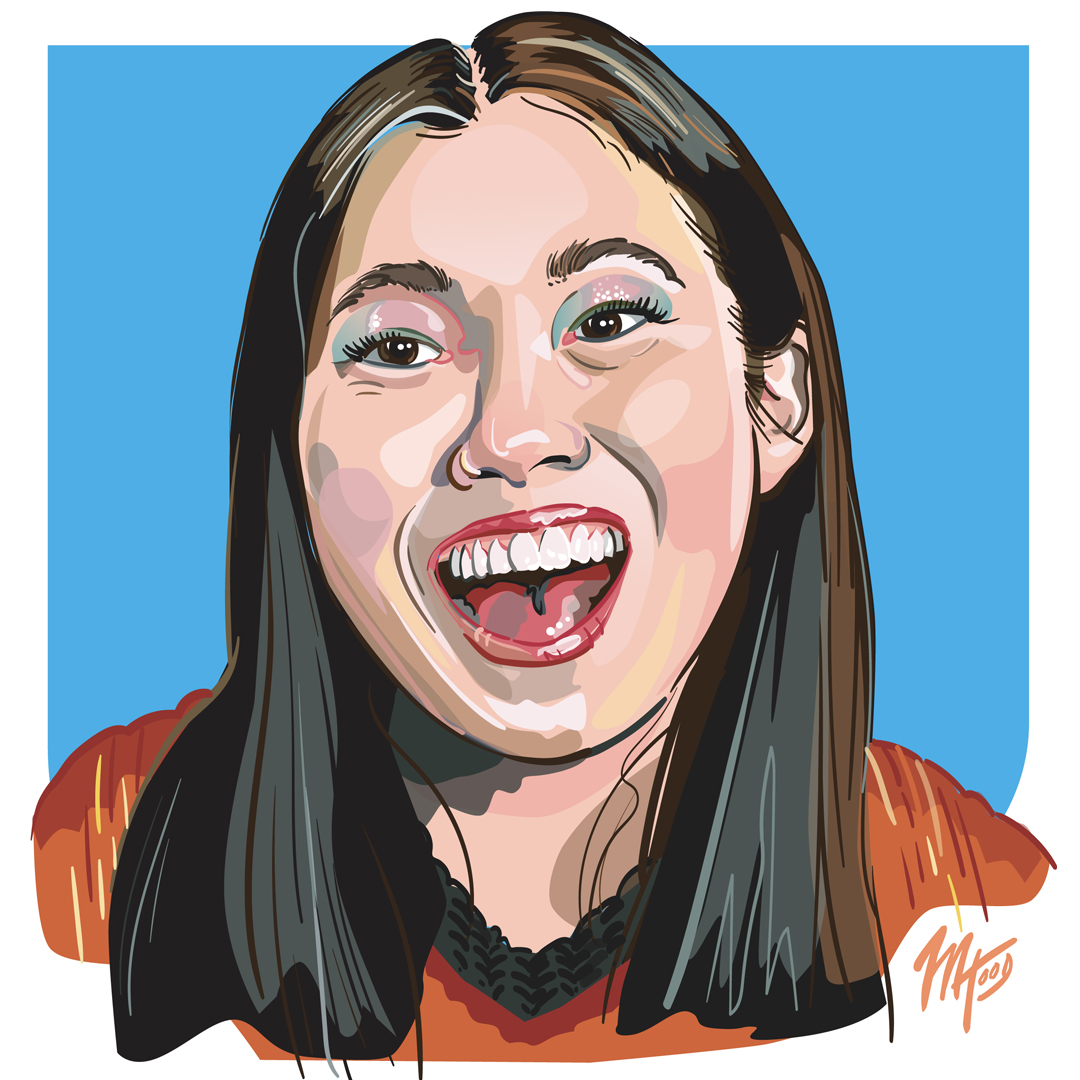

O is for Michelle Obama
“When they go low, we go high.”
Michelle Obama delivered this line at the 2016 Democratic National Convention in a speech supporting Hillary Clinton’s nomination for President. It was the motto, she said, that she and President Barack Obama had tried to instill in their daughters when they were faced with bullies or people who questioned their father’s faith or citizenship. They shouldn’t stoop to that level, she told them.
In addition to being a mother of two, a lawyer and a successful author, Michelle Obama was the first African American to serve as First Lady of the United States. She used the position to advocate for poverty awareness, education, healthy eating and physical activity.
Michelle was born in 1964 and raised in the South Side of Chicago. She was determined to do well in school and was accepted in Chicago’s first magnet program high school. The daily commute to the school took three hours.
She attended Princeton University where she majored in sociology and minored in African-American studies. She then pursued a law degree from Harvard.
After graduating Harvard, Michelle went to work at a Chicago law firm. She was assigned to mentor a new summer associate. His name was Barack. They married in 1992. He was elected to the Illinois state senate in 1996 and to the U.S. Senate in 2004.
Michelle was initially a reluctant campaigner for her husband, and she faced often unfair criticism. Her sarcasm was pilloried in the press. And a Fox News columnist referred to her as an “angry Black woman.”
But when they went low, she went high. As First Lady she was noted for her grace, dignity and style. She championed causes for military families and LGBTQ+ rights. As part of her healthy eating initiatives, she planted an organic vegetable garden on the White House lawn, the first time there had been a garden on the property since Eleanore Roosevelt’s Victory Garden during WWII.
Going high has worked well for Michelle. In 2020, four years after leaving the White House, a Gallup poll named her the most admired woman in America… for the third year in a row.
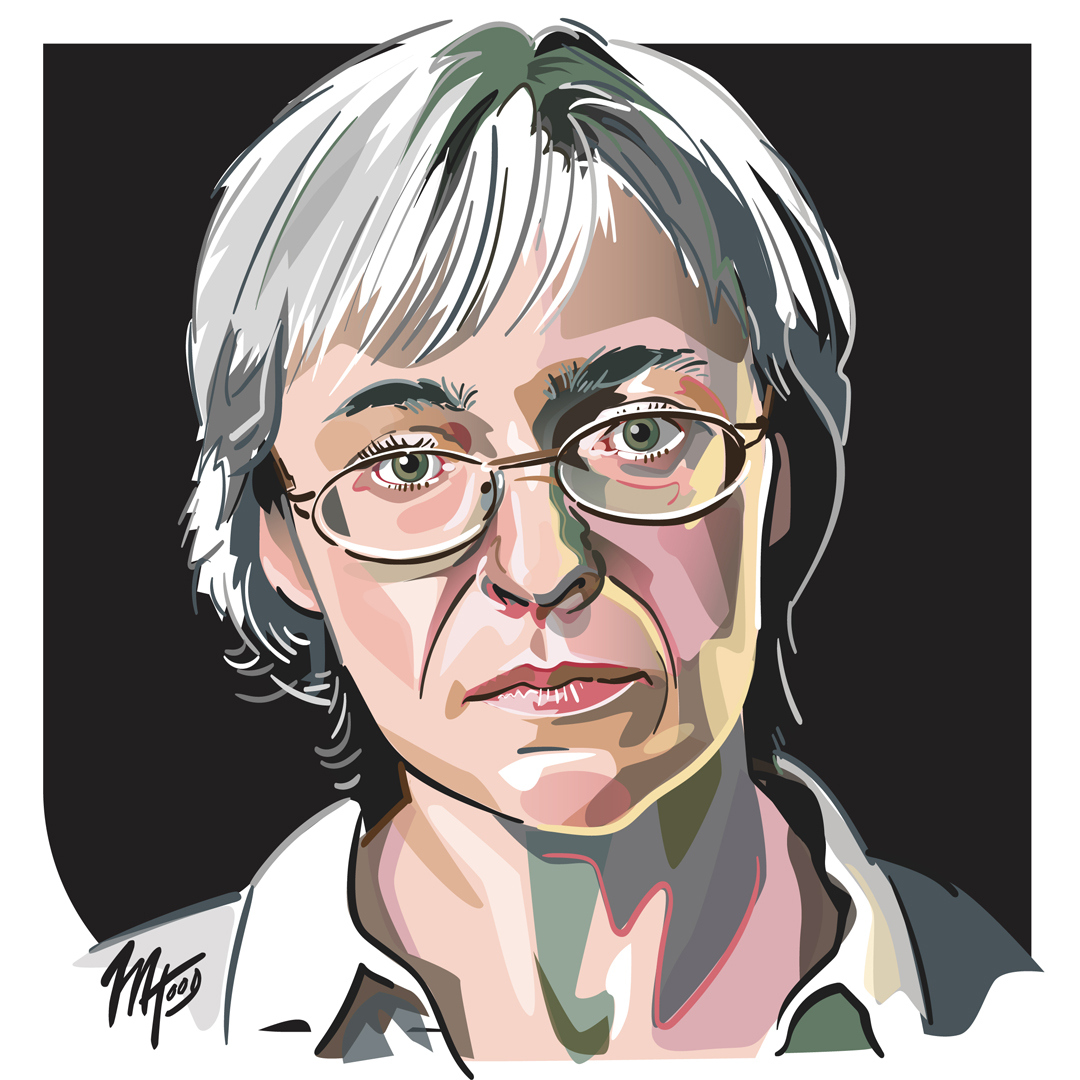
P is for Anna Politkovskaya
Anna Stepanovna Politkovskaya was a Russian journalist and human rights activist who was murdered in 2006, undoubtedly on orders from the Kremlin, because of her efforts to expose the truth about Vladimir Putin’s savage wars in Chechnya.
Politkovskaya was born in 1958 in New York City to Ukrainian parents who were Soviet diplomats at the United Nations. She spent most of her childhood in Moscow, graduating from Moscow State University’s school of journalism in 1980.
Politkovskaya gained fame as a war correspondent during the Second Chechen War which began in 1999. She tried to shed light on crimes committed by the Russian military, human rights abuses, ethnic cleansing, and the bombardment of civilian homes in the capital city Grozny. When order had been supposedly restored to the area under the pro-Moscow Kadyrov regime, Politkovskaya continued to report on the torture, abduction, and murder that were common place in the new local government.
Her commitment went beyond just journalism. She was closely involved in negotiations to release hostages taken in a Moscow theater in 2002. Two years later, when children were taken hostage in a school in the North Caucasus town of Beslan, Politkovskaya boarded a plane to go negotiate. Before she could take off, she became violently ill from poisoning—a trademark of the Kremlin.
In 2006, she was investigating the widely held theory that Putin had ordered the bombing of several Russian apartment buildings in 1999, killing hundreds of innocent Russians. Chechens had been blamed for the bombings, and they were used as a pretext for the second invasion of Chechnya. On October 7, 2006, she was found in the elevator of her apartment building, shot twice in the chest, once in the shoulder, and once in the head at point blank range.
Thousands of mourners filed past her coffin at the funeral. In June 2014, five men were sentenced to prison for involvement in the murder. Although it remains “officially” unclear who ordered her killing, anyone watching Putin’s latest crimes against humanity in Ukraine should have little doubt about who ultimately ordered Politkovskaya’s execution.
Q is for Queen Elizabeth II
England has had more than 60 monarchs in its approximate 1200 years of existence. Queen Elizabeth II is longest living and longest reigning of them all. Having ascended to the throne in 1952, she is also the longest-serving female head of state in the written history of the world.
Born on April 21, 1926, Elizabeth wasn’t supposed to be queen. Only after her uncle, King Edward VII, shocked the world by abdicating in 1936 did Elizabeth come in line for the throne. Elizabeth’s father became King George VI upon that abdication. He died a short 16 years later, and Elizabeth, at the young age of 25, became Queen of the United Kingdom (England, Scotland, Wales and Northern Ireland), Canada, Australia, New Zealand, South Africa, Pakistan and Sri Lanka.
During her 70 years as queen, her realm has shrunken as some territories have gained independence or become republics. England’s status, too, has changed in that time as it joined the EU and then withdrew 47 years later with Brexit. Her reign saw the Troubles in Northern Ireland, war in the Falklands, combat in the Iraq and Afghanistan, terrorist attacks in London, economic booms and busts, and, most recently a global pandemic.
In an example of how long her reign has been, Elizabeth is the only British monarch to appear on television, because the medium wasn’t mainstream prior to her becoming queen. Indeed, the world has changed immeasurably in seven decades, and Elizabeth has had to balance cultural evolution with a staid job full of inflexible traditions hundreds of years old. At times, she has missed the mark. Perhaps most notably, opinion soured with Elizabeth’s initial standoffish handling of Princess Diana’s death in 1997.
This year, the UK celebrates the Queen’s Platinum Jubilee, 70 years on the throne. And for 85% of people in her realm, Elizabeth is, quite simply, the only monarch they have ever known.

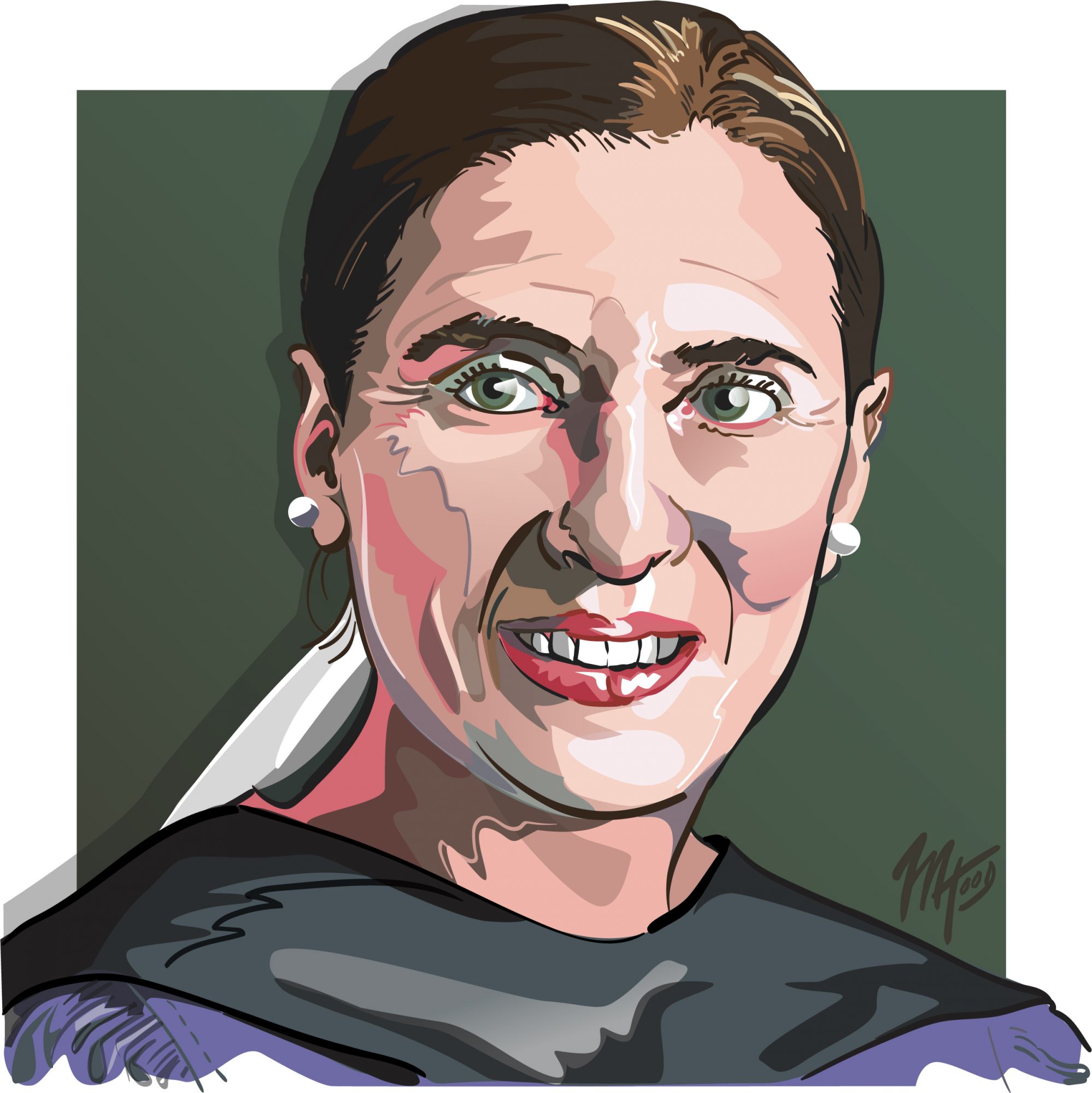
R is for Ruth Bader Ginsburg
In her more than 60 years as a legal professional, Ruth Bader Ginsburg did more to champion gender equality and defend women’s legal rights than perhaps anyone before.
Born in 1933 to Jewish immigrants, Joan Ruth Bader grew up in Brooklyn, New York. She was not allowed to have a bat mitzvah because of Orthodox restrictions about women reading from the Torah. It was, she thought, an injustice, and one that would foreshadow her professional raison d’etre.
She attended Cornell University, where she met her future husband, Martin Ginsburg. In 1956, she enrolled at Harvard Law School, one of only 9 women in a class of 500 men. She transferred to Columbia Law for her third year. In 1959, she graduated tied for first in her class.
Despite her academic achievements, Ginsburg had trouble finding a job. Law firms weren’t hiring women lawyers. She instead worked as a professor at Rutgers Law School, where she was paid less than male contemporaries.
In 1972, Ginsburg co-founded the Women’s Rights Project as a division of the ACLU. In less than two years, the project took on more than 300 gender discrimination cases. Between 1973 and 1976, Ginsburg argued six gender discrimination cases before the U.S. Supreme Court, winning five. Thanks to Ginsburg’s efforts, women won the right to have credit cards and bank accounts in their own names.
In 1980, President Carter nominated Ginsburg to the D.C. Circuit Court. In 1993, President Clinton nominated her for the U.S. Supreme Court. After her confirmation, she became only the second female (after Sandra Day O’Connor) to sit on the court.
Originally considered a moderate consensus builder, Ginsburg became more and more a leader of the body’s liberal wing as the Court’s makeup skewed rightward.
She had her first of five bouts with cancer in 1999. By 2010, at age 77, she was the oldest member of the Court, but she resisted calls to retire while a Democrat was president. Ginsburg died on September 18, 2020, six weeks before the 2020 election. And despite her final wishes, Donald Trump and a Republican-controlled Senate pushed through a replacement weeks before Democrats would take control of the White House and Congress.

S is for Gloria Steinem
This portrait of Gloria Steinem is based on photos from the late 1960s and early 1970s. At the time, she was unquestionably the face of America’s new feminist movement. Many of the rights that women take for granted today (not to mention some of the rights that are under attack by some conservative politicians today) were first achieved because Steinem fought for them as an activist and wrote about them as a journalist.
Much of Steinem’s early life was spent on the road, whether it was in the company of her traveling salesman father or studying abroad as a student. In 1957, at the age of 23, Steinem had an abortion while in England. At the time, the procedure was still illegal. The experience certainly shaped her later activism. She ardently believed that women should have a legal choice about keeping or terminating a pregnancy. And they should have the freedom of choice about when to start a family or whether to even get married at all.
As a journalist, Steinem had long-form articles published in Esquire, Cosmopolitan, and New York Magazine. She wrote about “the pill” and female contraception. She also examined the choice women often had to make between having a career and starting a family. She argued that women should be able to work and advance in any field, and they should be paid the same as male counterparts.
For one article, she even went undercover as a Playboy bunny at one of Hugh Hefner’s now-defunct Playboy clubs. She wrote about the sexual exploitation these hostesses endured. The experience had unintended consequence for Steinem. For quite some time afterward, magazines didn’t want to hire someone who’d worked in the “sex industry.”
In 1972, Steinem made a lasting contribution to journalism and gender equity when she co-founded Ms Magazine, which was the first national magazine devoted to feminist issues.
T is for Greta Thunberg
Not yet 20 years old, this young woman from Sweden has been an environmental activist on the world stage for more than six years. She began her “school strike” movement in 2015, when she started skipping school to wait outside the Swedish Parliament, demanding that her leaders take climate change more seriously.
Soon students in multiple countries had taken up striking for the environment under the moniker “Fridays for Future.” By 2019, there were multiple coordinated protests throughout the world, each with over 1 million students participating.
In 2019, Thunberg was invited to address the United Nations Climate Action Summit. She had previously convinced her parents to reduce the family’s carbon footprint by giving up air travel. She traveled from Sweden to the U.N. in New York on a carbon-neutral sailboat.
From the beginning, Thunberg was noted for her direct and assertive speaking style to people in power. Her speech to the UN was no different. “How dare you?” She chastised the collective body for their lack of concrete action on climate change.
That direct style may also be a part of Thunberg being on the autism spectrum. As a child, she was diagnosed with Asperger’s syndrome, obsessive-compulsive disorder (OCD) and selective mutism (SM), an anxiety disorder in which people who can otherwise speak are struck mute by specific stressful situations. In one of her first speeches on climate change, Thunberg described her selective mutism as meaning she “only speaks when necessary.”
The collective affect of human action (and inaction) on our environment has certainly made a voice like Thunberg’s a necessity. More people are beginning to agree. She was Time Magazine’s youngest Person of the Year. And she has been a nominee for the Nobel Peace Prize three times, in 2019, 2020, and 2021.
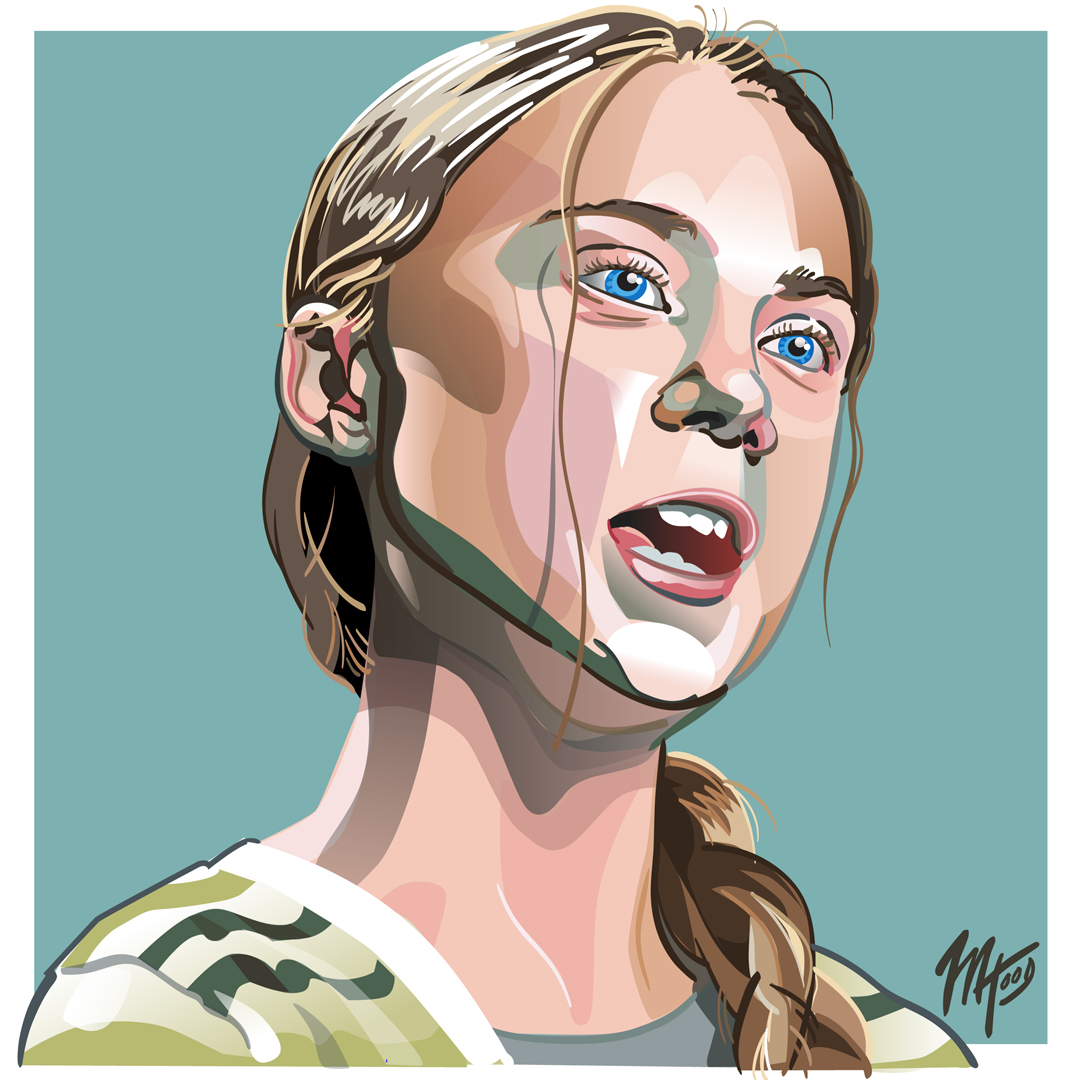
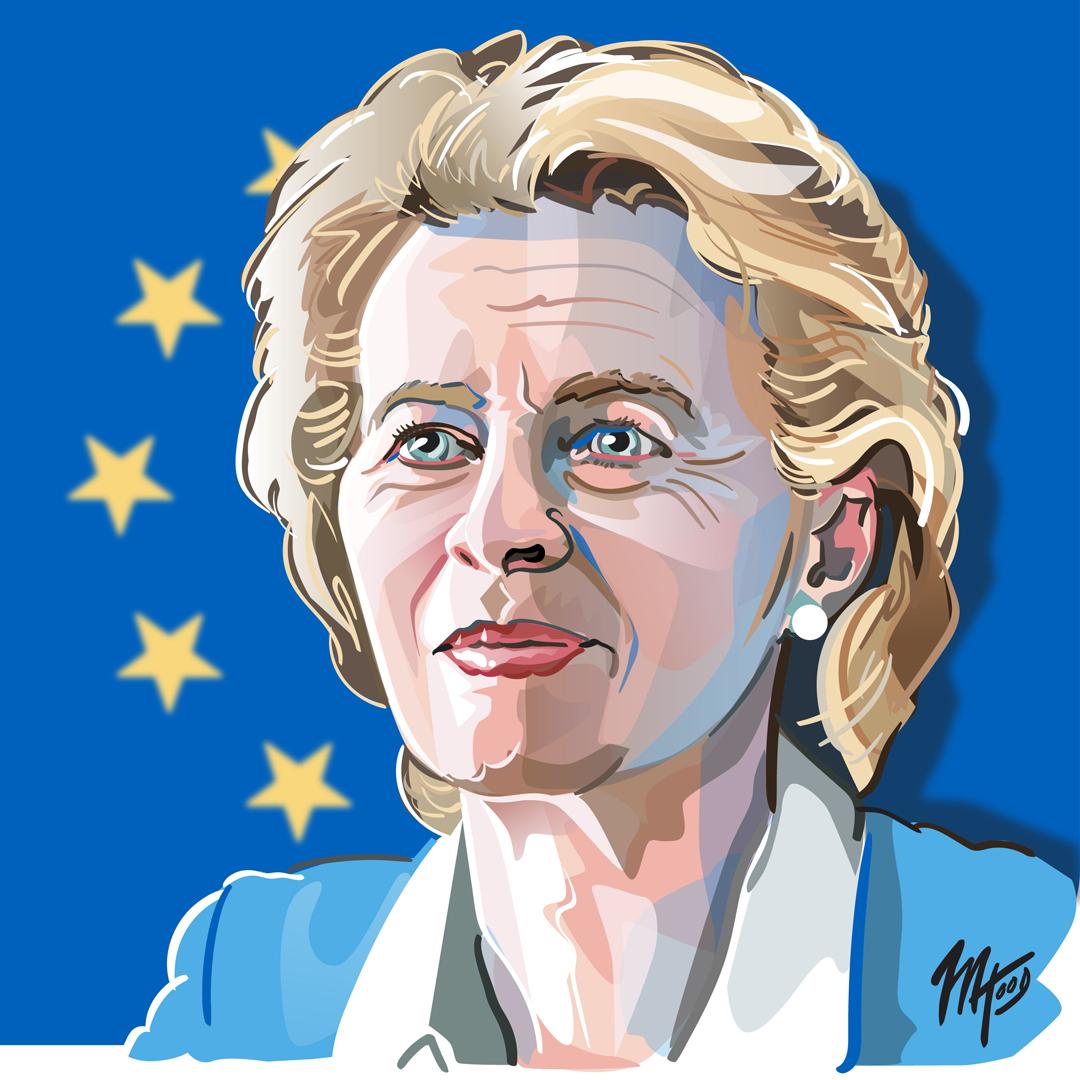
U is for Ursula von der Leyen
Ursula von der Leyen would have an impressive resume and busy schedule if one stopped with the fact she is a medical doctor specializing in women’s health and also the mother of seven. When one adds that she was Germany’s first female Minister of Defense and is now the first woman to serve as President of the European Commission, her accomplishments take on historic scope.
Born in 1958 in Brussels to EU diplomats, she was raised speaking both French and German. She relocated to her ancestral home near Hanover, Germany, in the early 1970s. Her father was a prominent politician by this time, and because of that Ursula became the target of a kidnapping plot by the communist Red Army Faction. Her family sent her to London where she spent more than a year living under an assumed name and with Scotland Yard protection.
She was able to return to Germany in 1979 and enrolled in medical school, graduating with her MD in 1987. She became active in politics in the 1990s as Germany tackled reunification. She joined the CDU and rose through the ranks on a path similar to that of her future boss, Angela Merkel.
During her time in politics, von der Leyen has championed progressive ideas. In 2005, she oversaw a 4.3-billion-euro project to build new childcare facilities throughout Germany. She also advocated for an increase in paid parental leave. Her commitment to families was not limited to those of a traditional definition. She pushed for equal adoption rights for same-sex partners. As Minister of Defense, she introduced a 100-million-euro plan, to improve family life for those serving in the German military.
After her tenure in Merkel’s cabinet, von der Leyen returned in 2019 to where it all started for her—Brussels—but now as President of the EU’s governing body.
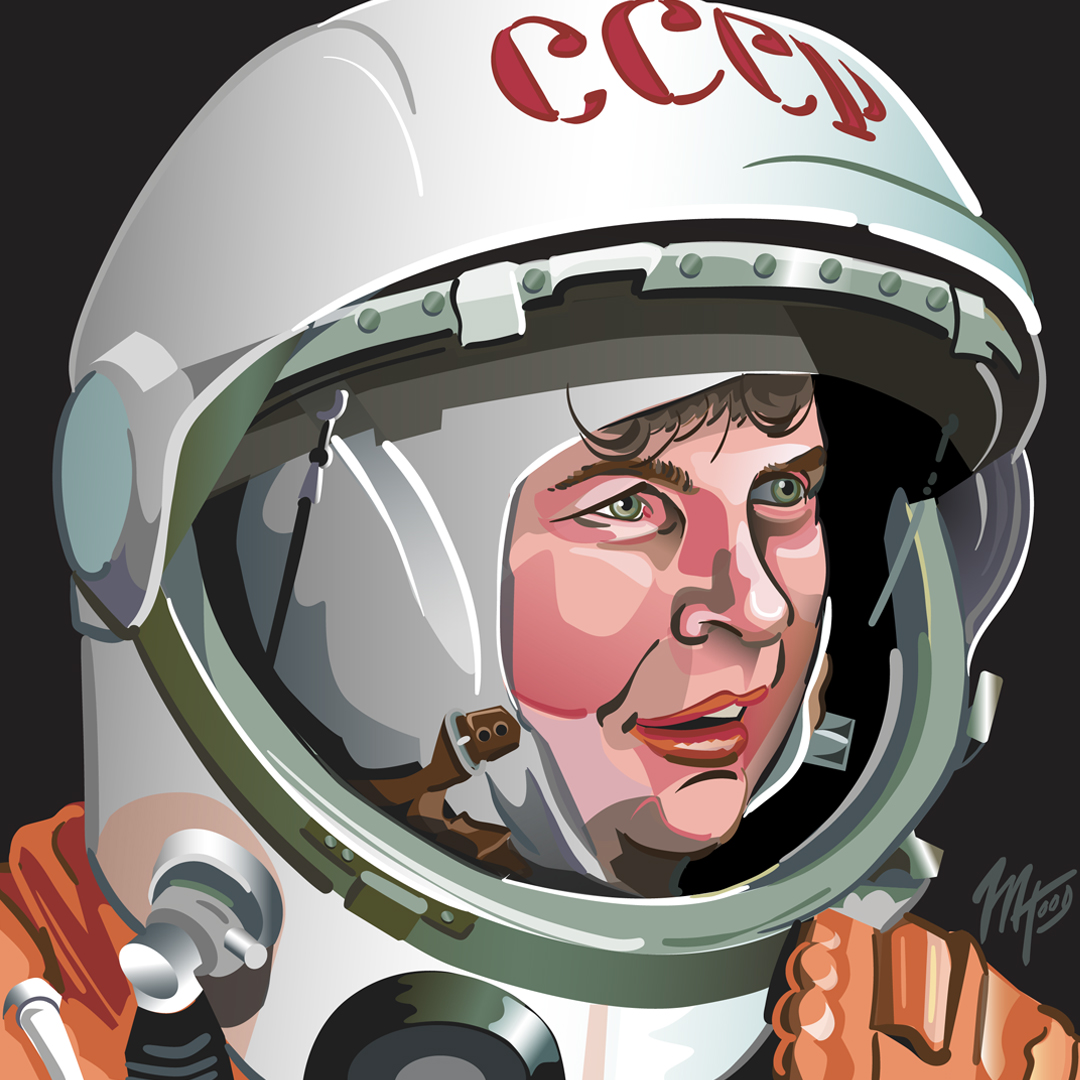
V is for Valentina Tereshkova
As far as glass ceilings go, the one Valentina Tereshkova broke was literally higher than any before or since. On June 16, 1963, Tereshkova, a Soviet Cosmonaut, became the first woman in space. Even today, almost 60 years later, she remains the only woman to ever fly a solo mission in space.
Tereshkova was born in 1937 in European Russia, about 170 miles from Moscow. Her father was a tank commander in the Red Army who died in the Finnish Winter War when Valentina was only three.
At a young age, Tereshkova went to work at a textile mill and only graduated from school because she completed courses via mail when she wasn’t working. Also at a young age, Tereshkova became fascinated with parachutes. While at the textile mill, she would jump off of anything and everything. Eventually, she joined a Soviet skydiving club.
After Yuri Gagarin became the first man in space in 1961, the Soviet government decided they wanted the USSR to also have the distinction of putting the first woman in space. The criteria included that the woman be an expert parachutist. Throughout the country, 58 women met the requirement. Tereshkova was one of five invited to become a cosmonaut, and eventually the woman chosen for the first mission.
Tereshkova piloted her spacecraft, Vostok 6, for 48 orbits around the Earth. The mission lasted two days, 22 hours and 50 minutes. Her return to earth emphasized her prerequisite parachuting skills. Unlike early American space missions where parachutes slowed the entire space capsule upon reentry, the Vostok 6 mission ended with Tereshkova ejecting from the capsule when it was still 4 miles from the ground. She was buffeted by high winds as she rode her parachute down.
So ended Tereshkova’s one and only trip to space. She remained with the Soviet Air Forces and eventually earned a doctorate in aeronautical engineering. She retired in 1997 with the rank of Major General. Today, she is a member of Russia’s national legislative body, the State Duma.
W is for Wangari Maathai
Wangari Maathai’s story is one of overcoming the obstacles of colonialism, corruption, and chauvinism. She more than overcame; she became the first African woman to ever win the Nobel Peace Prize.
Wangari was born on April 1, 1940 in a small village in central Kenya, which was still a British colony at the time. Most of the people in her village could neither read nor write. But despite the odds, Wangari not only learned to do both, in 1959, she was one of 300 Kenyans who received financial aid to study in the United States in what became known as the Kennedy Airlift.
She studied biology and chemistry, earning her Bachelor’s degree from Benedictine College in Atchison, Kansas, and later a Master’s degree from the University of Pittsburgh. She returned to Africa to the University College of Nairobi, and became the first Eastern African woman to ever receive a PhD.
In 1977, she put her scientific knowledge to practical use fighting deforestation. She started the Green Belt Movement, which encouraged women to plant tree nurseries. Wangari demonstrated how to find native seeds and plant trees that were sure to grow in Kenya. Eventually the program spread to 15 other African countries, and Wangari was able to pay the women a small stipend from funds she had secured from the UN.
As colonialism was crumbling in Eastern Africa, many new national governments were corrupt and dedicated to the enrichment of certain tribes or ethnic groups, with all of the governments run by men. Wangari endured ethnic and gender discrimination, with the Kenyan Government opposed to her empowerment of women. Furthermore, the Kenyan Government was more interested in selling trees than planting new ones.
Multiple times, Wangari was arrested and beaten. Once she was the target of a foiled assassination plot. But just as she overcame obstacles to her education, Wangari outlasted the cronyism and crumbling remnants of colonialism. In 2002, she ran for parliament in Kenya and won. In 2004, she was awarded the Nobel Peace Prize for her “contribution to sustainable development, democracy, and peace.”
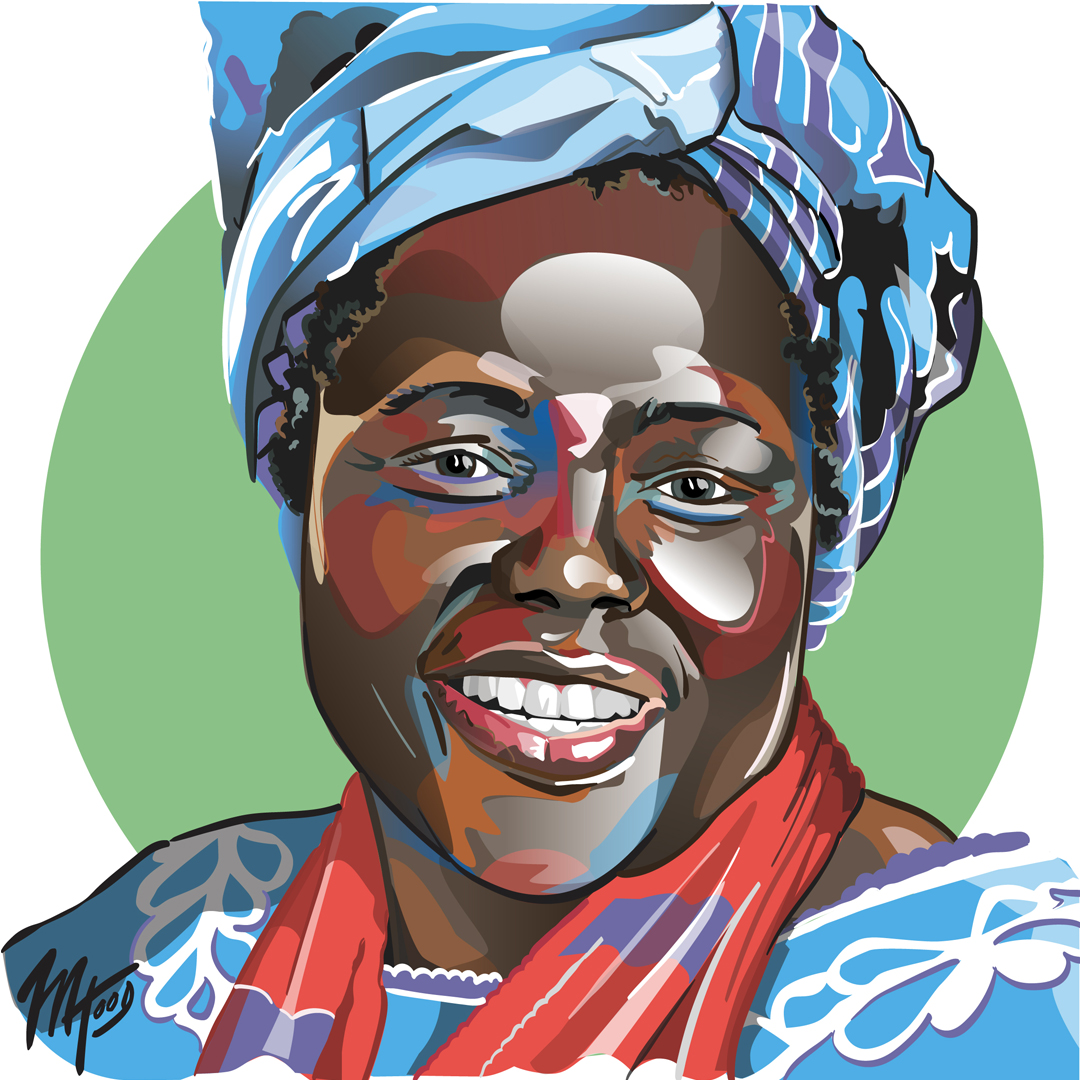
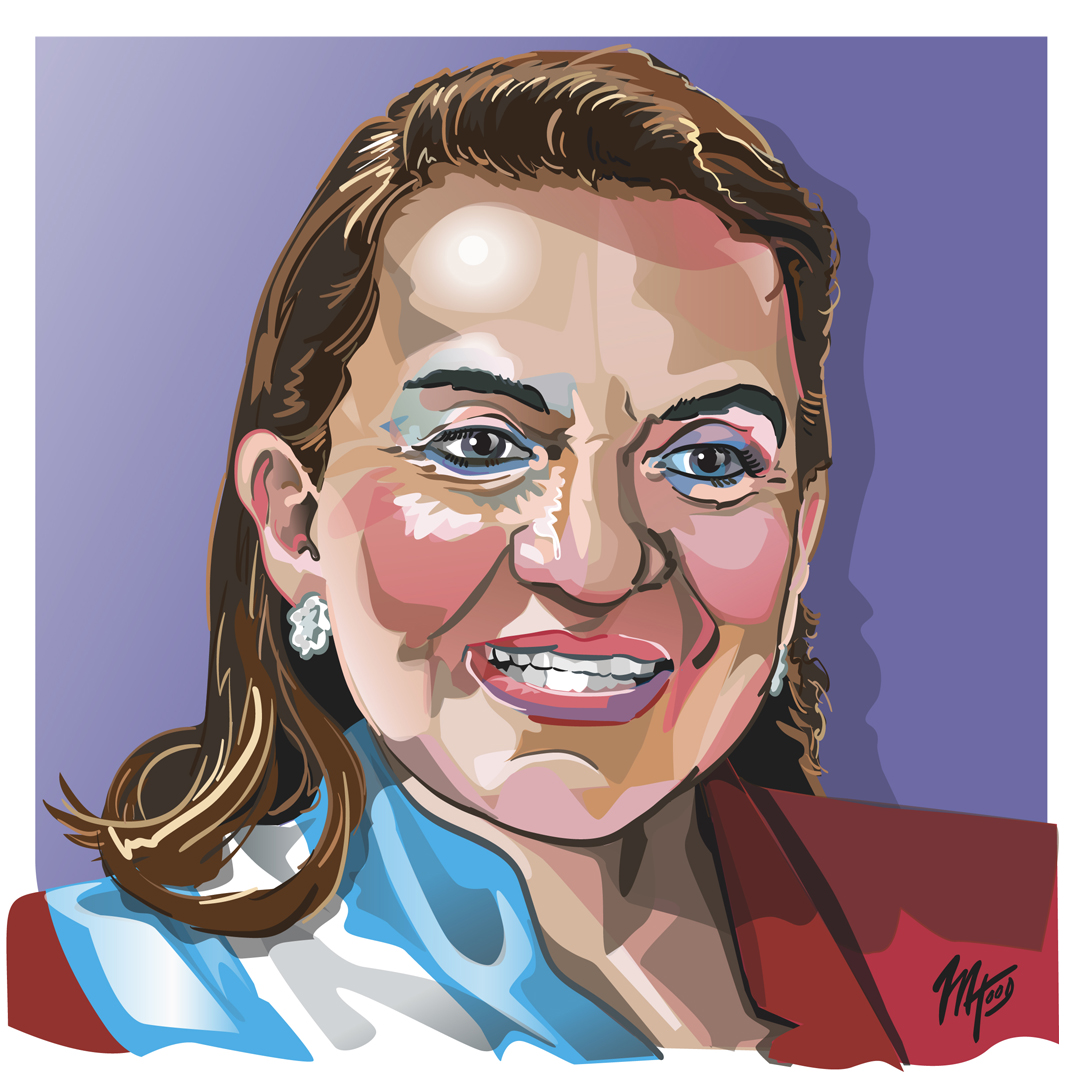
Xiomara Castro
Xiomara Castro is the first ever female president of Honduras, elected in November 2021. That in and of itself is a biographical highlight, but it is her potential and the change she represents for her country that makes Castro extraordinary.
Castro’s life in politics began as the First Lady of Honduras. Her husband, Manuel Zelaya, was elected under the Liberal Party banner in 2005. But in 2009 he was abducted from his home and forced into exile in a coup d’état orchestrated by the military. Castro led thousands of Hondurans into the streets in demonstrations demanding the restoration of her husband’s freely elected administration. But the new government violently suppressed the democratic activists.
For the next decade, conservative officials enriched themselves from the public coffers while the nation at large slipped further into impoverishment. At the end of 2020, Honduras was one of the poorest countries in the Americas. Gang violence was endemic, political assassination was an everyday risk, and the environment was abused to the breaking point by mining and hydro-electric developers emboldened by governmental graft.
But things are starting to change. Castro spent her time since the coup creating, organizing, and empowering a new political party called Libre. Twice she ran for office unsuccessfully. Then in November 2021, Castro ran for president and, despite long odds, won thanks in large part to support from young voters and a historically high voter turnout.
She has a momentous task in front of her to make Honduras more equal and democratic. She has plans for a new anti-corruption commission supported by the UN and a rewrite of the country’s constitution to better enshrine socialist-democratic ideals. She has also pledged to stamp out the underlying causes of the country’s systemic poverty and support more rights for women.
It remains to be seen if Castro will be successful. But her accomplishments as president can only mean good things for the people of Honduras.

Y is for Malala Yousafzai
Because of her commitment to girls’ education and her bravery in the face of religious zealots who tired to murder her for her activism, Malala Yousafzai at the age of 17 became the youngest person to ever receive the Nobel Peace Prize.
Malala was born in 1997 to a Pashtun family in the Swat region of Pakistan. Her father was an educator who ran a series of schools. But secular education—particularly the education of girls—was a dangerous proposition in Pakistan in the early 2000s. The Tehrik-i-Taliban, a militant group of Islamist extremists, was fighting the Pakistani military for control of the country.
The Pakistani Taliban was actively blowing up schools and forbidding the education of girls. An uneasy peace fell over the Swat Valley in 2009 and girls were allowed back in schools, but faced heavy restrictions.
The Urdu version of the BBC, in an attempt to cover the story of life under the Taliban in Pakistan, sought out a female student who would blog about her daily life. Most families thought it was too dangerous an assignment, even if the blogger remained anonymous. Eventually, Malala’s father volunteered his 12-year-old daughter.
Between her father’s educational activism and Malala’s blog, she became a target of the Pakistani Taliban. On October 9, 2012, a masked gunman stormed Malala’s school bus, demanded to know which child was Malala and then, when she was identified, shot her in the head.
Miraculously, she survived. She received care at a local hospital and was transferred to a hospital in the UK. International condemnation of the assassination attempt was swift, and it cast the spotlight even brighter on the plight of women and girls who opposed Sharia law.
After her recovery, Malala remained in Birmingham and became a prominent educational activist and advocate of women’s rights. She co-authored a book, “I Am Malala” in 2013, and it became an instant international bestseller.
In October 2014, Malala was named as the recipient of the Nobel Peace Prize for her “struggle against the suppression of children and young people and for the right of all children to an education.”
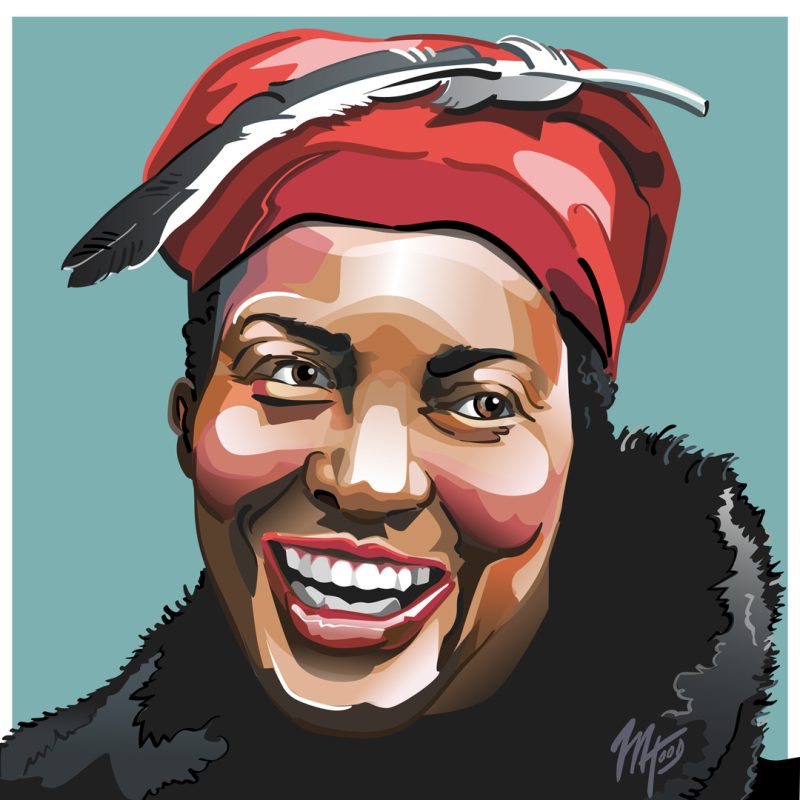
Z is for Zora Neale Hurston
Zora Neale Hurston was a cultural anthropologist and writer. She was raised in the post-slavery South and became a key figure in the 1920s Harlem Renaissance, but her ability to combine cultural research with African folklore in her writing transported Black voices and the Black experience far beyond just Harlem or the American South.
Born in 1891 in Alabama, her family relocated to Eatonville, Florida, which was one of the first incorporated all-Black communities in the U.S. Her father was one of Eatonville’s first mayors. Hurston had a happy childhood of relative privilege, but that all changed with her mother’s death and her father’s quick remarriage in 1904. Hurston left home at the age of 13 and joined a traveling theater group.
Despite her new itinerate life, Hurston completed her primary education and went on to earn an associates degree at Howard University and studied anthropology at Columbia University. Her scientific study of society influenced how Hurston was able to portray the Black experience in literature.
In 1926, she and other figures in the blossoming Harlem Renaissance movement created a literary magazine. In it, she published an essay entitled “Sweat.” It was groundbreaking in its feminist themes and story of a woman seeking societal independence.
Hurston traveled the South and journeyed to Jamaica and Haiti to gather stories of the African diaspora. In 1937, these interviews came together in her most famous novel, “Their Eyes Were Watching God.” The book opened a new window onto Black lives and recorded previously unheard Black voices in an unvarnished way, exposing their hopes, desires and human failings.
Despite her literary contributions, Hurston was not widely known during her lifetime. She died in poverty in 1960, and she might have been forgotten were it not for another Black, female author. In the 1970s, Alice Walker, famous for her novel “The Color Purple,” became a champion of Hurston’s writings. No other author had yet provided a fuller, more nuanced picture of Black lives and honest Black voices, Walker said as she dubbed Hurston “the matriarch of Black literature.”
